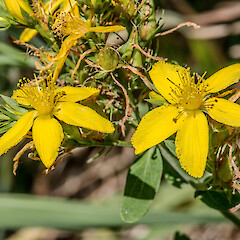Hypericum perforatum
Common name
St John’s wort
Family
Hypericaceae
Flora category
Vascular – Exotic
Structural class
Herbs - Dicotyledons other than Composites
NVS code
The National Vegetation Survey (NVS) Databank is a physical archive and electronic databank containing records of over 94,000 vegetation survey plots - including data from over 19,000 permanent plots. NVS maintains a standard set of species code abbreviations that correspond to standard scientific plant names from the Ngä Tipu o Aotearoa - New Zealand Plants database.
HYPPER
Conservation status
Not applicable
Habitat
Terrestrial. Disturbed short tussockland, herbfield, bare land.
Wetland plant indicator status rating
Information derived from the revised national wetland plant list prepared to assist councils in delineating and monitoring wetlands (Clarkson et al., 2021 Manaaki Whenua – Landcare Research Contract Report LC3975 for Hawke’s Bay Regional Council). The national plant list categorises plants by the extent to which they are found in wetlands and not ‘drylands’. The indicator status ratings are OBL (obligate wetland), FACW (facultative wetland), FAC (facultative), FACU (facultative upland), and UPL (obligate upland). If you have suggestions for the Wetland Indicator Status Rating, please contact: [Enable JavaScript to view protected content]
UPL: Obligate Upland
Rarely is a hydrophyte, almost always in uplands (non-wetlands).
Detailed description
Hairless perennial herb to 1 m tall. Roots with slender, creeping rhizomes. Stems singly or severally from base, erect, round with 2 ridges, woody at base, upper branches in opposite pairs at 45 degrees. Leaves in opposite pairs, stalkless, narrow to oval, 10-27 x 1-8 mm, with many translucent glandular dots. Flowerhead a terminal, flat-topped panicle, dense, many-flowered. Flowers star-like, 8-20 mm diam, golden yellow, with 5 black-dotted petals, Dec-May. Stems usually die in autumn, leaving prostrate, barren, leafy shoots, often forming dense mats.
Similar taxa
may be confused with many other closely related Hypericum spp, 5 adventive and 2 native. The native species lack black glandular dots, and are low to mat forming.
Flowering
December, January, February, March, April, May
Flower colours
Black, Yellow
Life cycle
Perennial. Relatively long-lived. Reproduces from seed and rhizomes; numerous seeds are contained in capsules. Seeds via wind (minor), possibly livestock. Rhizomes via soil and water movement.
Year naturalised
1869
Origin
Eur, W Asia, N Afr
Reason for introduction
Accidental
Tolerances
Tolerates hot to cold temperatures, damp and drought, wind damage and is not grazed (poisonous).
Etymology
hypericum: From the Greek hyper (above) and eikon (picture), the plant was hung above pictures to ward off evil spirits
perforatum: From the Latin perforatus ‘pierced with holes’, depending on the species this may refer to the foliage covered in punctate oil glands










